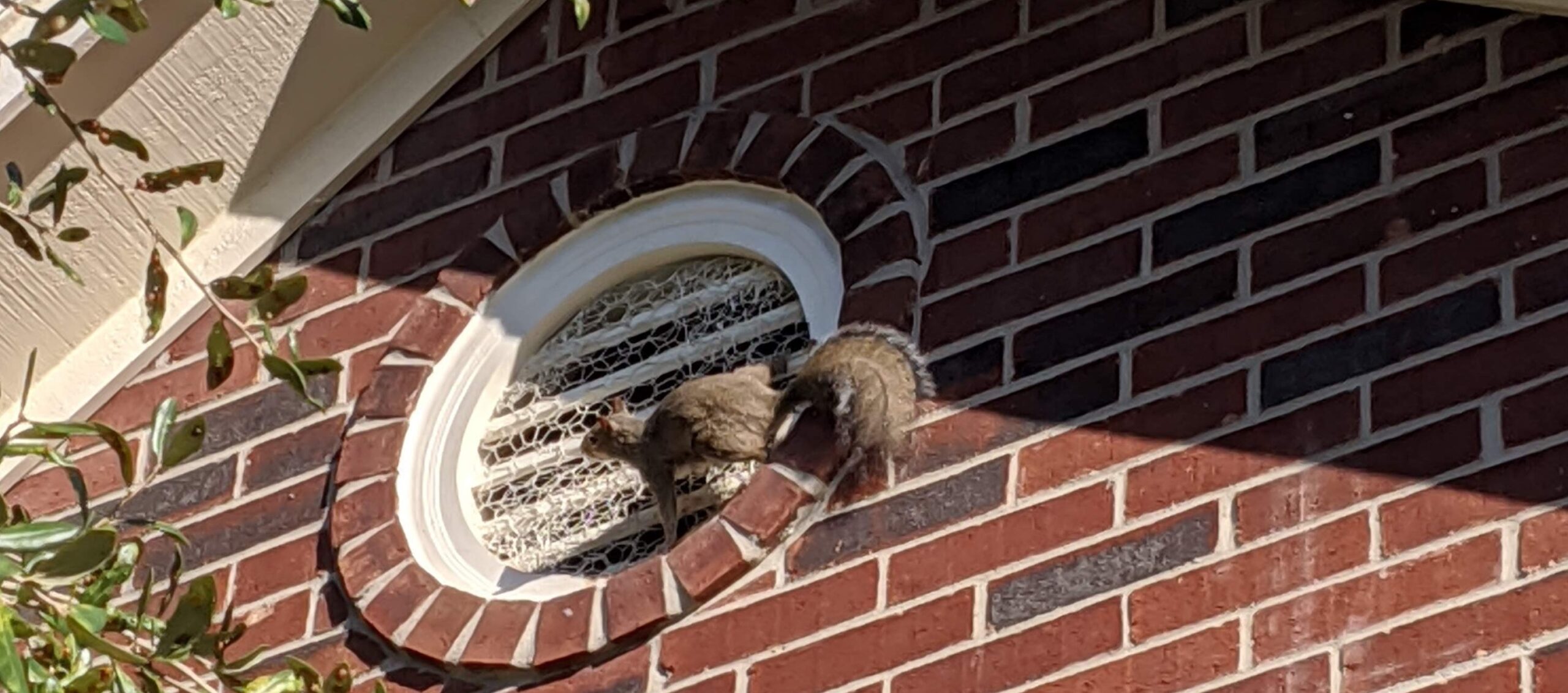The first sign of a possible squirrel problem is hearing sounds of scampering  overhead early in the morning or as you’re sitting down to eat dinner. Once you head to the attic to investigate, you may be welcomed by a distinctive animal smell. You look over and catch sight of a bushy tail and confirm you have a squirrel living in your attic.
overhead early in the morning or as you’re sitting down to eat dinner. Once you head to the attic to investigate, you may be welcomed by a distinctive animal smell. You look over and catch sight of a bushy tail and confirm you have a squirrel living in your attic.
What Problems Do Squirrels in the Attic Cause?
While looking for entry points into your attic, squirrels may cause damage to soffits, siding, chimney flashing, fascia boards, and various types of exhaust fans. Once a squirrel has gained access to your attic, they will build nests with outside materials they have brought in, such as sticks and moss. Since animals do not have a designated bathroom area, they will leave urine and droppings throughout the attic.
Although rare through transmission, squirrels can carry pathogens like Salmonella and rabies. They can also damage property from gnawing on wood to chewing through wires, causing potential fire hazards.
Why Do Squirrels Like Living in Attics?
Squirrels favor building their nests near openings like loose or rotten trim boards and unscreened vents. It’s not uncommon to find adult female squirrels nesting in your attic as they are easily able to store food and raise their young. Attics also allow squirrels to build their nests in a warm and safe environment without fear from outside elements or predators.
What are the Signs of Squirrels in the Attic?

- Sounds. There’s a good chance you’ll hear a squirrel before you see any visual evidence, especially during winter months, where you’re less likely to notice exterior damage. The sounds squirrels make are often described as scurrying, scampering noises in attic. You might also hear chewing or gnawing sounds. Squirrels like building their nests in attics, so sounds will often emanate from there. Squirrel sounds are often mistaken for rat sounds, but there’s one key difference: squirrels are diurnal, so you’ll hear them during the day, whereas rats are nocturnal, and will make more sound at night.
- Nests in Your Attic. Squirrels are well known for nesting in attics, as they provide a safe hideaway for squirrels to raise their young. The inside of an attic is also full of things for them to nibble and sharpen their ever-growing teeth on, like wood and insulation. When a squirrel chews the insulation on electrical wiring, the possibility of a house fire arises. Squirrels enter attics through crevices, gaps, and cracks in soffits, fascia boards, and eaves, or open vents or broken shingles in the roof. Once squirrels reach the attic, they have free reign of the house.
- Squirrel Droppings Inside Your Home. Squirrel droppings are often confused for rat droppings, and vice versa. While rat and squirrel droppings do look similar—dark brown to black in color with blunted ends, around 3/8 of an inch long—they are found in different places around the home. Squirrel droppings are often found in attics or around tree trunks, while rat droppings are more common along baseboards, in cupboards, and behind large appliances like washing machines.
- Chewed Roofing Materials. Another popular nesting site for squirrels is in the roof. Typically, they build these nests with roofing insulation. Take some time to carefully analyze your home’s exterior. Squirrels commonly damage roofs by:
- Chewing holes in soffits. This can allow other small pests to invade your home.
- Biting through shingles. This can lead to water damage.
- Eating through joists and siding. This can weaken your home’s structure.
To prevent squirrels, it is critical to keep one’s roof in good shape. Regularly inspect it for any damage, and repair as needed. To cover small holes, use steel mesh, not aluminum or plastic. Squirrels can chew through plastic and soft metals like butter.
How Can I Prevent Squirrels from Making My Attic Their Home?
There are laws in many states that do not allow the trapping and relocation of squirrels without a permit, making squirrel removal a much more complicated process to achieve both humanely and legally.
Making sure tree branches are cut will lessen a squirrel’s access to the roof, while chimney caps help keep squirrels out of the chimney as well as any other wildlife such as birds, bats, and raccoons.
If you have bird feeders in your yard that squirrels eat from, try buying ones that don’t drop seeds on the ground. You can also try putting cayenne pepper on the bird feed. Birds won’t notice the difference, but the squirrels will. Making an effort to deter squirrels from being in your yard, can help prevent them from making your attic their home.
Contact us on the web or call us at 817-225-2217 to schedule a free consultation for squirrel in attic removal.




